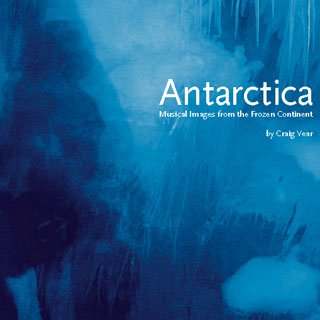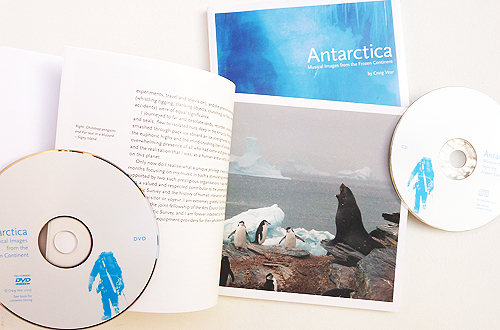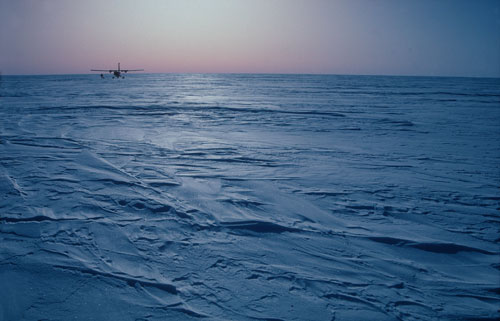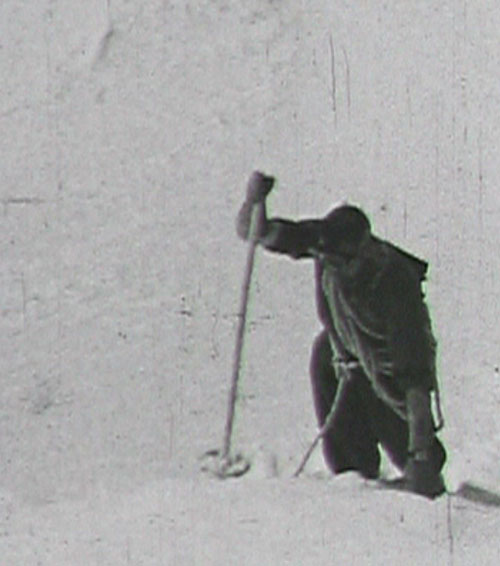
Antarctica: Musical Images from the Frozen Continent | Craig Vear
GrD 23 | DVD/Book/CD – PAL format (Europe) > [Sold Out]
Please order NTSC format (US) via earthear.com
Reviews
In the winter (Austral summer) of 2003/4 I embarked on an ambitious musical project in Antarctica, having been awarded a joint fellowship from Arts Council England and the British Antarctic Survey’s Artists and Writers Programme. The purpose of my visit was to compile a unique library of field recordings from the Antarctic and sub-Antarctic regions, which would become the sound source for music composition.
The focus of my many field recordings was to capture and reflect the relationship between the British Antarctic Survey (BAS) and the continent it embraces, and the life and populations of the area surrounding the Weddell Sea. Under these headings, the natural sounds (wind, sea, weather and wildlife), the human sounds (scientists living and working, boat captains, ‘talking heads’ interviews and conversation), the mechanical sounds (machinery, generators, boats, scientific experiments, travel, entertainment), and the phenomenological sounds (whistling rigging, clanking objects, crunching ice floes, musical accidents) were of equal significance.
I journeyed to far and desolate lands, recorded colonies of penguins and seals, flew to isolated huts deep in the Antarctic Peninsula, and smashed through pack ice aboard an ice strengthened ship. I experienced the euphoric highs and the mind-crushing lows of solitude, the overwhelming presence of all who had come and gone, together with the realisation that I was, as a human and an artist, a mere speck on this planet.
The main artistic product of my three-month journey is Antarctica, a large-scale surround-sound electroacoustic composition, created from this sound library compiled during my residency. Selected sounds were layered, stacked, collaged and combined to form a rich and complex theatre of sound.
DVD Contents:
Antarctica 26′
5 Antarctic Solitudes 12′
History Of Icelandic Music 10′
76˚South a Video Journal 8’40“
CD Contents:
1 Adelie Penguins 12′
2 Iceberg 9’26“
3 Elephant Seal colony 7’24“
4 Fur seal colony 9’38“
5 Ship through Ice 10″
6 Melt water and morraine 7’14“
Excerpts:
1. Extract from 5 Antarctic Solitudes #4
2. Opening from Antarctica
3. First vocal quartet from Antarctica
Antarctica is presented here on DVD and features:
– Dolby Digital 5.1 / Stereo / Director’s commentary
– Multi-angle visuals
– Five Antarctic Solitudes: new short films created from archive Antarctic film footage
– The composer’s video journal
– CD containing Antarctic field recordings
– 88 page book containing unique Antarctic images, the composer’s Guardian Diaries, detailed descriptions of the composition and recordings, plus transcriptions of the voices used in the composition’s ‘Vocal Quartets’
Gruenrekorder / Germany / 2012 / GrD 23 / LC 09488
Caity Kerr | The Field Reporter
Antarctica: Musical Images from the Frozen Continent is a fine thing to have in your possession. This dvd/book/cd release by Craig Vear is jam-packed with goodies, from field recordings to radio works to still images to musical compositions and archival footage. Vear’s page at Gruenrekorder lists the contents in full.
In this review I’ve chosen to focus on the field recordings, presented on audio cd, though I’ll also offer reflection on the music of 5 Antarctic Solitudes.
The first thing that struck me about the field recordings is that they’re all captured by means of condenser microphones, that is, no hydrophones or contact microphones in sight. It surprises me slightly because ever more field recordists are working in remote natural environments with a range of microphones and high-end recording devices, widening the scope and conceptual range of what we might consider to be conventional ‘nature recording’. Although Vear was working in 2003/4, not so long ago, we can see how the topography of field recording’s ‘political economy’ has changed between then and now, Now we have the financial might and reach of influential media institutions like the BBC attempting to spearhead the field, alongside scientific enterprises in which artists have access to multi-channel hydrophonic arrays to the tune of tens of thousands of pounds. All things considered, Craig Vear has done very well with his (by today’s standards) modest resources.
The cd offers us six pieces, three recordings of penguins and sea mammals and three which focus on the sounds of sea, ice and water, with a hint of ‘pure’ ambience. I’ve never been to Antarctica, though I have a large map on my studio wall which I gaze at with longing and desire every day, but I have been to the Falklands and South Georgia and have sailed around the South Atlantic and I can tell you that the marine environment and the wildlife is utterly captivating. That and the fact that the constellations are upside down and the clouds seem to spiral in the wrong direction.
Vear’s approach is to plonk himself right in the middle of a heaving mass of snorting, farting, grunting, creaking and slabbering large seals, which, at times, if you didn’t know better, might be mistaken for certain species of primate. The penguins are hardly less restrained in their persistent chattering and fretting. For a ‘frozen continent’ the place is heaving with life and energy. One can only imagine the racket going on beneath the dark ever-changing surface of the southern oceans.
One piece captures the vessel James Clark Ross smashing through the sea ice. Here we can sense the danger as a metal hull, essentially your survival suit, enters into combat with the forces of nature at close quarter. There are interesting lulls between the crashes and rushes of ice and water – the unfolding sound field is dynamically unpredictable, with similar qualities to a fragile mountain bothy rattling in high winds and rain. Personally, I’d have taped a few contact mics to the hull to capture the effect of the stresses that the vessel was put under as it ploughed through the sea ice, but that doesn’t detract from a very fine recording.
The most intriguing of the six recordings is the last, entitled Glacial Melt Water and Moraine. Here I assume that we are on the actual land mass of the continent, right up against the body of the glacier. The listening environment is ambiguous, at times very gentle and restrained, but sounding also a note of tension. Although it ends with the most delicious wind flurries, it tends towards what I would call ‘pure’ ambience, most often captured at altitude, but which in this context will be the signature sound across most of the magnificent land mass. Call me perverse, but I’d like to listen to an hour or so of microphones placed right out in the vast snowfields on a very cold day.
The 5 Antarctic Solitudes are more ‘musical’ pieces, accompanying (or accompanied by?) archive footage of early Antarctic explorers and their dog teams carrying out their tasks in the very bleak black and white scratchy world of old film; hardy fellows to say the least. I could have watched the old films for hours.
Some of the pieces consisted of free and loose jazzy improvisation, Played by Vear and musical colleagues, lending a Chaplin-esque atmosphere to the film. Others made use of glitch and scratchy sounds, beats made of noisy blips and so on. Fashionable at the time (2003/4), these sounds are dated now, at least to my ears, such are the vagaries of fashionable sounds.
Finally, the History of Icelandic Music is a wonderful radio piece, in the broadest sense of the term, making use of narrative, field recordings and intriguing recordings of various Icelandic musical instruments – perhaps best described as a somewhat innovative work of ethnomusicology.
As I said at the beginning, this is a fine ‘objet d’art’ to have in your hands. I can seem myself dipping into it from time to time, glancing wistfully at my map of Antarctica and dreaming on the pure ambience of the frozen desert.
„A complex musical web, sometimes like a film soundtrack, sometimes a radio play, sometimes a nature documentary – a voyage of discovery and excitement through one of the last remaining natural places on the planet.“ TONY MYATT
From WFAE Soundscape Journal:
Vear offers listeners a wealth of creative responses to this place. The centerpiece of the package is a 26-minute composition, titled simply “Antarctica.” The piece weaves sonic elements gathered on the journey, including the sounds of travel, wind, and animals, along with the voices of four different people reflecting on their times in Antarctica. The voices, presented in several “vocal quartet” sections, are sometimes distinct, sometimes layered, sometimes distant emanations of the land itself, and offer rhythmic and melodic elements that are central to the piece, as well as a grounding place amidst the utterly baffling sounds of many of the animals whose voices become part of the mix. Adding to the sense of exploration and discovery that permeate the piece are the three choices presented on the DVD to accompany the composition: a slide show of photographs from the trip (which bear no obvious relation to the unfolding soundscape), a slowly changing wash of colors, or no visuals at all. The piece is presented in both stereo and 5.1 versions, and a “director’s commentary” offers Vear’s annotations about the sounds used in the composition, and his compositional process.
The DVD also offers five shorter pieces, titled Antarctic Solitudes. These feature archival video, often slowed down, and generally fascinating, with soundtracks that are more electroacoustic and abstract, also composed largely from recordings made on the trip. In addition, Vear presents an earlier audio work, “The History of Icelandic Music,” that uses similar compositional techniques (the blending of found sound and human voices) to those used for “Antarctica.” Finally, the DVD includes a eight-minute “Video Journal” that gives a taste of Vear’s travels, by boat, plane, and foot.
The audio CD features extended tracks of source recordings that are in some ways the most compelling part of the package. These rich soundscapes are beautiful, very strange, and quite immersive. Vear carries our ears perhaps even further out than Quin did on the Antarctica CD he produced for Wild Sanctuary, which is no mean feat. Penguin and seal colonies create a holy racket that is very different than the animal choruses we are used to in temperate zones, while three extended water-oriented tracks create their own immersions in soundscapes most of us will never hear, and likely never imagine. The colony recordings seem to set us amidst uproarious activity, while the water pieces are all about motion in and through water and ice.
The book that accompanies the discs (one of which slides into each cover) is just a bit larger than a normal CD booklet, and at 88 pages, is a substantial document in its own right. Photos bring the trip alive visually, while Vear’s journals provide a sense of the long days of travel (his expedition sailed a huge triangle to islands off the southern Argentinean coast before heading south to Antarctica), the mind-boggling expanses of rock, ice, and penguins, and a magical few days on his own in a remote hut built by early British surveyors. Several pages are devoted to transcriptions of the five recorded recollections used in the piece, presented in parallel to each other on the page, as they are similarly presented in the composition.
The three elements of this publication are wonderfully complementary, each informing the others in new ways as the listener explores them repeatedly over time, with very little repetition or overlap between the book, CD, and DVD. It all adds up to an extremely coherent artistic presentation, and is most highly recommended.





